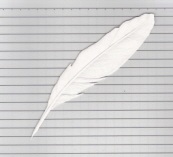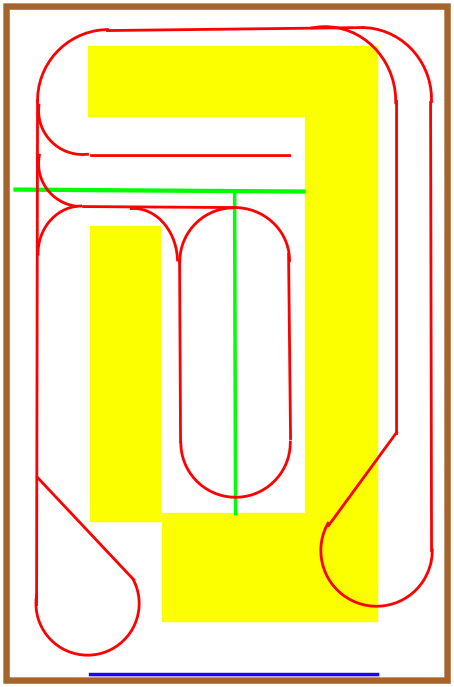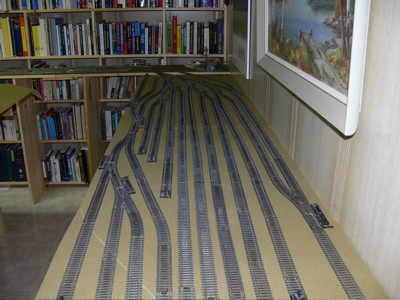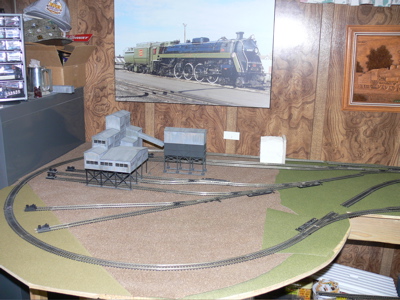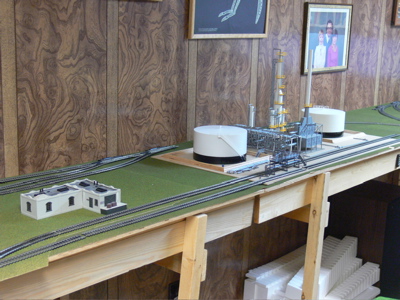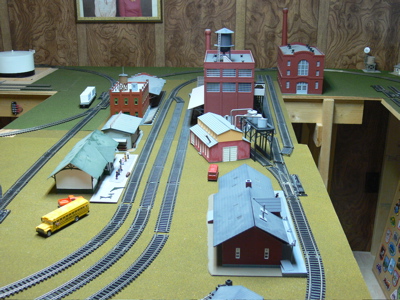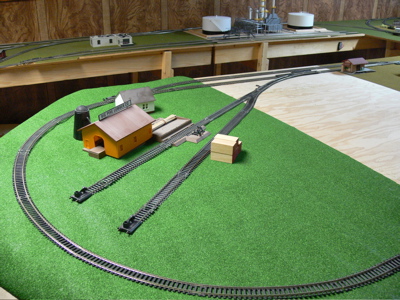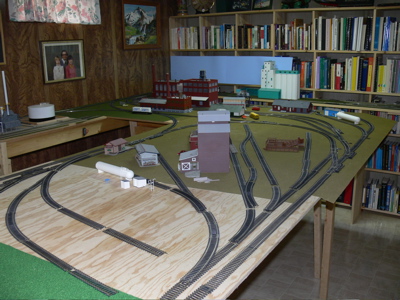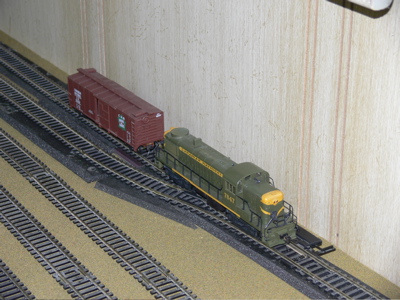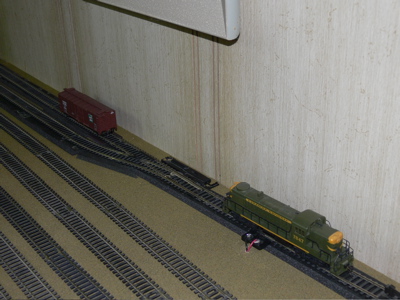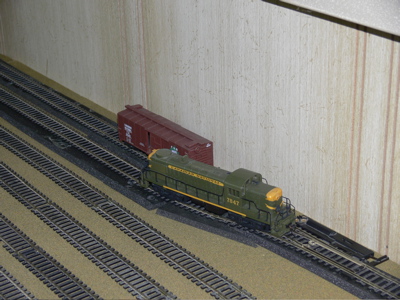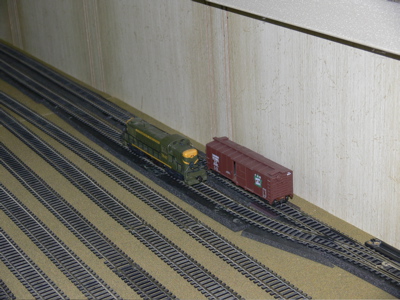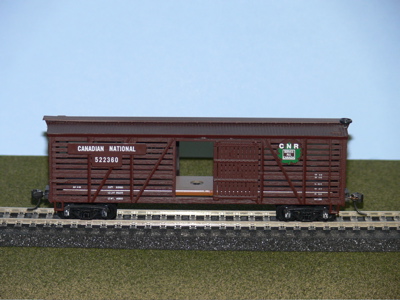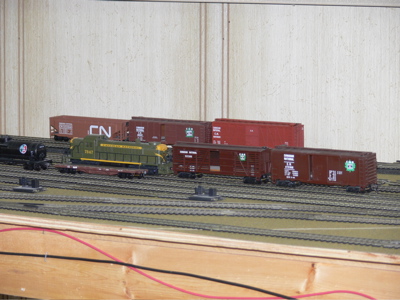 |
9:20 PM I have been playing downstairs with my layout for about 5 hours today. I have a clear idea of the track layout for both the main yard and the coal mine.
I have added the sheets of ground cover to most of the layout and have begun placing the track on top of this to see how it works when I actually have to use track sections of pre-determined length and curvature.
In creating these two track layouts I have come to appreciate the significance of having a long lead track at the entrance to each yard. This is necessary for the yard engine to carry out its duties without having to enter the mainline and thus potentially cause difficulties for trains on the mainline. Such a long lead track has never been part of my thinking when considering layouts until now.
My approach to a final layout is a mix of heuristics and careful planning. The diagram below represents my original basic plan. Since then it has been modified by turning the right side into a one-ended large yard. The only other change to the mainline is to continue the track that is second from the top in the diagram to join the right hand side of the oval loop just below it. This creates a mainline run through Queenston.
The heuristics come into play as I begun to view the overall layout and try to place passing sidings and switching turnouts for the various structures and industries. At the moment I have Coaldale pretty well established. It is all track and no structures. I also have Black Diamond (the coal mine) set up with the proper switching track and a long lead so a switching engine, without entering the mainline, can move the empties to the mine and remove the loads to a siding for pickup by a mainline locomotive.
The two remaining large areas are Queenston (a town with a number of industrial buildings and sidings) and Distillery Row (a large refinery complex with storage tanks and a loading platform). The remaining three areas (Pine Ridge [lumber mill], Paradise Valley [farming] and The Channon [small village]) are all relatively small and should be easy to fit in.
I prefer working with a large empty table and then seeing what happens when I place a few structures on it and then try to set the track to service them. Or sometimes I begin by placing the track and then seeing what buildings can fit into the arrangement. I also have a large grain terminal that would look very nice with a couple of long sidings containing about 8 - 10 cylindrical grain cars. Once again, the idea is to set up the track so a train can drop off about 8 cars and pick up a similar number.
At the moment I do not have any sidings on the mainline. This means that only one train can be running on the mainline at a time. I will try to set up a siding on the left side and two more on each side of the oval.
I have yet to make a final decision on whether to use visual barriers or not. I will wait until I have the layout more or less set and then I will set up a temporary barrier and see what I think of it.
The mainline track enters Coaldale from the top right. The train arrives on the rightmost track and the locomotive uncouples from the car and reverses back on the siding track beside the mainline. The eight tracks in the middle are called classification tracks. This is where a switching locomotive will create new trains which will be picked up by a mainline locomotive and taken out from Coaldale along the mainline track in the upper left corner of the image to the rest of the layout. The remaining tracks on the left of the Coaldale yard are holding tracks for spare locomotives, cabooses and cars requiring maintenance. It is possible for the yard locomotive to disassemble an incoming train and create a number of new trains without ever entering the mainline track.
There are 7 siding tracks for the Black Diamond mine. The nearest two are for empty cars, the middle three are loading tracks (the coal drops down into the cars from the mine complex), and the two lines furthest away are for loaded cars ready to be picked up by a mainline locomotive.
1:40 PM My first iteration of the overall layout is now complete.
I will need to buy a few more turnouts to complete this layout, but at least the present indications are that it is workable.
7:05 am I now have a roughed-out plan for the entire layout. It is time to begin laying track with a foam roadbed and thumb tacks. This will provide an operational test of the entire layout. At the same time I will install the necessary wiring and thus begin to run trains again. My goal is to have a DCC system operational before Christmas.
I envisage two power districts: the outer mainline and the inner mainline. The outer mainline will consist of Coaldale, Distillery Row and Black Diamond. Essentially this is the layout along the outer walls of the room. The inner mainline will consist of Queenston, The Channon and Pine Ridge. This is the layout in the center of the room.
The control panel will be placed at the end of the Coaldale yard and will control all the turnouts on the mainlines. There are 9 turnouts on the outer mainline and 12 on the inner mainline. I will also have separate control panels for handling the turnouts for each of the local switching areas: Coaldale, Distillery Row, Black Diamond, Queenston, The Channon and Pine Ridge.
As with my previous layout, I will begin with a smaller section of the outer mainline, lay the track on a roadbed, wire it, and then running a small train on it to see how it works operationally. One of the advantages this time is that I have a good understanding of what is involved in doing the wiring.
12:30 PM The layout is operational. I have foam underbed for the mainline arrival track in the Coaldale yard. I have power on the arrival track in the Coaldale yard. I have one locomotive, CN 7847 (an Alco RS-3 diesel), and one boxcar, CN 501417, currently on the layout. I was able to run a test of automatic coupling and uncoupling using the under the track magnet that will be used to uncouple the train from the mainline locomotive and then have the locomotive do a run around to leave the yard. This was the first time that I have tried coupling and uncoupling since I began working with my trains a few months ago. There is a genuine feeling of satisfaction to be able to do this without touching the train.
However the idea of using thumb tacks to fasten down the track does not work with the foam underbed. The tack fails to reach the plywood. I will leave the foam underbed that I have put down this morning but will not add any more as I want to use the thumb tacks to verify that the overall mainline layout is electrically sound and that I like the operational feel of trains on this setup. Then I will convert to DCC and verify that I have that working properly. Finally, I will reinstall the track using the foam road bed.
There is still lots of work ahead. I will now begin tacking down the track and adding additional wiring for power every 4 - 6 feet.
9:15 am I have thumb tacked down and cleaned the complete outer mainline track. CN 7847 left Coaldale at 9:00 am and went as far as Distillery Row before reversing direction and returning to Coaldale. The trip was uneventful, however the power in the line at that point was too weak to continue. The next step will be add some additional wiring to boost the signal strength. There is a reversing loop around the coal mine at Black Diamond that will require special wiring for DC until I purchase the DCC equipment. Before I do the special wiring I will run a locomotive to the loop and then reverse it back to Coaldale. This will at least test the track for signal strength.
I will also try to complete some maintenance on two or three more cars and then add them to the layout. Track fastening and cleaning, wiring, and car maintenance gives a fair amount of variety to the day.
7:40 PM I have added one 4 terminal barrier strip to the layout. I now have power connecting to both ends of the Coaldale mainline track.
The power problem was due to a short circuit where a loop of track fed back on itself. I thought I had insulated the point of connection but a close examination indicated that I had missed this one connection. As soon as I replaced the metal connectors with a pair of plastic connectors I had full power on the locomotive for the entire length of the outer mainline track. Great. I need to buy some more 4 terminal barrier strips before continuing wiring the outer mainline track.
I dusted off two more cars and checked the couplers for height and action. CN 473966 (a box car) and CN 522360 (a stock car) are now on the layout. Diesel locomotive CN 7847 picked each of these cars up from a siding in the Coaldale yard and moved them to a classification track.
